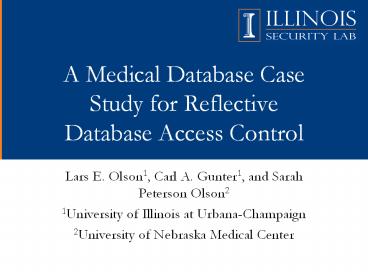A Medical Database Case Study for Reflective Database Access Control - PowerPoint PPT Presentation
Title:
A Medical Database Case Study for Reflective Database Access Control
Description:
A Medical Database Case Study for Reflective Database Access Control Lars E. Olson1, Carl A. Gunter1, and Sarah Peterson Olson2 1University of Illinois at Urbana ... – PowerPoint PPT presentation
Number of Views:231
Avg rating:3.0/5.0
Title: A Medical Database Case Study for Reflective Database Access Control
1
A Medical Database Case Study for Reflective
Database Access Control
- Lars E. Olson1, Carl A. Gunter1, and Sarah
Peterson Olson2 - 1University of Illinois at Urbana-Champaign
- 2University of Nebraska Medical Center
2
ACM-Based Access Control
Patients Patients Patients Patients Patients
Name Home Addr Optin Room Diag
Emily 1 Main St. Y 108 Flu
Fred 2 Center Ave. N 203 Broken leg
George 3 College Dr. Y 207 Lung cancer
Harriet 4 Park Blvd. N 301 Food poisoning
ACM Entries
Alice
Bob
3
ACM-Based Access Control
Patients Patients Patients Patients Patients
Name Home Addr Optin Room Diag
Emily 1 Main St. Y 108 Flu
Fred 2 Center Ave. N 203 Broken leg
George 3 College Dr. Y 207 Lung cancer
Harriet 4 Park Blvd. N 301 Food poisoning
4
ACM-Based Access Control
Second_Floor_Patients
ACM Entries
Carol
David
Fred
203
Broken leg
207
George
Lung cancer
5
ACM Weaknesses
- Complicated policies can be awkward to define
- All patients can access their own records
- Every nurse can view the records of patients
assigned to their floor
6
Motivation
- ACMs describe extent, rather than intent
- Decision support data is often already in the
database - Redundancy
- Possibility of update anomalies
7
Reflective Database Access Control
- Solution access policies should contain queries
- Not limited to read-only operations
- Policies not assumed to be omniscient
- Is this a secure solution? (CCS 08)
- Is this a practical solution? (DBSec 09)
- What is it useful for? (SPIMACS 09)
8
TD and RDBAC
- Transaction Datalog an extension to classical
datalog with update predicates - Query on a rule may change the database state
- Audit policies
- Chinese Wall policies
- Mathematical model enables formal security
analysis
9
Case Study Medical Database
- HIPAA legislation
- Protects privacy of patients
- Access to electronic health records must be
restricted based on the specific roles of the
members of their workforce. - Idealism meets reality emergencies are common
- Commonly implemented by Honor System, e.g. sign a
form yearly
10
Case Study Goals
- Demonstrate usefulness of RDBAC in a real-world
scenario - Enforce privacy constraints of HIPAA
- Address practical needs for emergency access
- NOT designed for a particular medical center
- BUT should be realistic
11
General Access Patterns
Database
12
General Access Patterns
Database
13
Example Policies
- Patients may view their own medical data
- Primary care physicians may view their own
patients data - Caregivers assigned to consult with a patient may
view that patients data - Lab technicians may enter new records for any
patient, but the ID of the technician is included
in the record - Current employees may access any patients
record, but an audit record is generated
14
Example TD Rules
- view.labResult(User, PtntID, Date, Type, ...) -
- labResult(PtntID, Date, Type, ...),
- person(PtntID, User).
- view.labResult(User, PtntID, Date, Type, ...) -
- labResult(PtntID, Date, Type, ...),
- person(UserID, User),
- hasAccess(UserID, PtntID).
- view.labResultEmerg(User, PtntID, Date, Type,
..., Note) - - labResult(PtntID, Date, Type, ...),
- employee(UserID, User),
- ins.labResultAudit(UserID, PtntID, now, Note).
15
Formal Security Analysis
- No untrusted user can ever gain access to a
patients lab results. - Automated analysis difficult (often impossible)
problem to solve - Safe rewritability
- Limits domain of values that untrusted users can
insert - Previously established theorem to decide analysis
- Must guarantee that untrusted users cannot
trigger actions that run as a trusted user
16
Results of Formal Analysis
- Uses upper-bound estimate on safely rewritable
policies - Rules with retractions, rules not safely
rewritable omitted - Sample database populated, verified with Prolog
- Omitted rules analyzed manually
- Analysis scalability
- Running time A increased patients doctors
- Running time B increased patients only
17
Results of Formal Analysis
18
Future Research Possibilities
- Improvements to TD
- Aggregation
- More expressive negations
- Improvements to analysis
- State-independent analysis
- Detecting irrelevant rules
- Development of Case Study
- Discretionary access to patient records
- Trusted users no longer constant
- Specifying exceptions
- Adverse drug interactions (requires negation over
join)
19
Conclusions
- Reflective Database Access Control is a more
flexible model than ACM-Based Access Control. - RDBAC provides benefits for real-world scenarios.
- More expressive policies
- Formal security analysis
20
For More Information
- http//seclab.illinois.edu/
- Internet search on Illinois Security Lab or
Reflective Database Access Control
21
Policies Defined with TD
- Policies may be written by lower-privileged users
- Problem read information from higher-privilege
table, write to lower-privilege - Solution
- TD rules include explicit parameter for the
permission - Policy subqueries are executed with definers
privilege - Policy body cannot do anything the definer cant
already do manually.
22
Analysis of Omitted Rules
- Infinite domain of values to insert
- Note value from break-the-glass rules
- Prolog can sometimes handle infinite domains
- Otherwise, these values do not affect access
privileges - Deletions still constitute subset of maximal
database - Executable only by trusted users
- Only active employees may execute rules
- Only trusted users may add active employees
- Any rules that invoke omitted rules are also
executable only by trusted users (transitive
closure)































